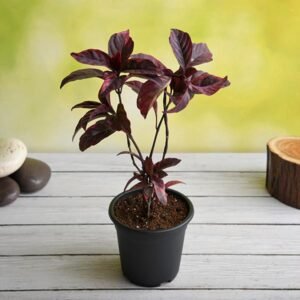Description
The Black Kodia Plant: A Botanical Enigma
The Black Kodia Plant is a rare and mysterious botanical specimen, renowned for its dark beauty, medicinal potential, and elusive nature. Native to the shadowy understories of high-altitude cloud forests and remote jungle canopies, the plant has fascinated botanists, herbalists, and folklore enthusiasts for centuries. Shrouded in legend and cloaked in ecological mystery, the Black Kodia remains one of the most sought-after yet least understood flora in the natural world.
Physical Characteristics
The Black Kodia Plant is visually striking, with an appearance that sets it apart from any known botanical species. Its leaves are broad, matte-black, and slightly iridescent, shimmering subtly in the light. The coloration is thought to be due to a high concentration of anthocyanins and unique pigment compounds not yet fully classified. Each leaf spans approximately 20 to 30 centimeters and grows in a spiral pattern from the central stalk, giving the plant a symmetrical, almost sculptural aesthetic.
The plant typically grows to a height of 1.5 meters, with its central stem being thick, fibrous, and dark violet in hue. During its rare blooming season—usually once every five years—the Black Kodia produces a single, large flower that has captivated the interest of both scientists and spiritual practitioners. The bloom is an inky purple-black with flecks of silver pollen, giving it the appearance of a night sky captured in petals. Its scent is intoxicating—a blend of jasmine, sandalwood, and myrrh—believed to have mild psychoactive properties.
Habitat and Ecology
Black Kodia thrives in shaded, moist environments with high humidity and stable temperatures between 10°C and 22°C. It is most commonly found in the deep forest floors of mountainous regions such as the Eastern Himalayas, the Congo Basin, and parts of Papua New Guinea. These environments provide the diffused light, rich soil, and moisture necessary for its growth.
Ecologically, the plant plays a role as both a symbiotic and defensive organism. It forms complex relationships with mycorrhizal fungi in the soil, aiding in nutrient absorption. Its dark coloration is not just aesthetic—it also helps it absorb what little light filters through the forest canopy, optimizing photosynthesis in low-light environments.
Interestingly, the Black Kodia exudes a mildly toxic sap that deters herbivores. This defense mechanism, coupled with its rare blooming cycle, contributes to its rarity and difficulty in cultivation.
Medicinal and Psychoactive Properties
One of the most intriguing aspects of the Black Kodia is its array of bioactive compounds. Indigenous communities have long used parts of the plant in traditional medicine. The roots are ground into a paste to treat inflammation, while the leaves are used in poultices for skin infections and wounds. A tea brewed from dried petals is said to alleviate anxiety and induce vivid dreams, often used in shamanic rituals.
Modern phytochemical analysis has revealed the presence of rare alkaloids, flavonoids, and terpene derivatives in the plant, some of which show promise in early-stage studies for their anti-inflammatory, neuroprotective, and adaptogenic effects. However, the full pharmacological profile of the Black Kodia remains under-researched, largely due to the plant’s scarcity and the difficulty in obtaining samples.
The flower’s silver pollen contains a psychoactive compound nicknamed kodiaphin, which has hallucinogenic effects when inhaled or ingested in small quantities. Tribal healers and shamans traditionally used the pollen in vision quests, spiritual ceremonies, and rites of passage, believing it to be a gateway to communicate with the spirit world.
Cultural Significance
Throughout the regions where it is known to grow, the Black Kodia Plant holds deep cultural and spiritual significance. Among the Qaba tribes of the Congo, it is referred to as “Nzala’s Eye”, a reference to their forest deity. They believe the plant is a divine sentinel, placed in sacred groves to watch over the balance between humans and nature.
In Himalayan folklore, the plant is said to bloom only in the presence of “pure intent.” Monks in secluded monasteries regard the flower as a symbol of enlightenment, and rare blooming events are marked by days of meditation, offerings, and storytelling.
Some cultures even revere the plant as sentient, claiming that it can “choose” who may touch or harvest it. This belief has given rise to strict rituals for approaching the plant, including purification rites, fasting, and chants.
Conservation and Rarity
Due to its extremely specific growing conditions and the accelerating degradation of its natural habitats, the Black Kodia Plant is critically endangered. Deforestation, climate change, and illegal poaching for the black market trade in rare plants have driven the species to the brink of extinction. Several environmental organizations have launched initiatives to protect its habitats and propagate the plant in controlled settings, but with limited success.
Attempts to grow the plant in botanical gardens or controlled greenhouses have proven challenging. The plant is sensitive to changes in light, soil pH, and even human presence, often wilting or becoming dormant when moved from its native environment. Its seeds also have a low germination rate, and the full life cycle of the plant is still not fully documented.
Myths and Legends
The enigmatic nature of the Black Kodia has given rise to numerous myths. In some legends, it is believed that the plant originated from the tears of a celestial being, mourning the destruction of nature. Others claim the plant grows on the graves of ancient healers, feeding on their spiritual energy.
A particularly enduring tale tells of a wandering healer who found the plant during a spiritual trial. Upon consuming the pollen, he received visions that cured a plague in his village. However, he was never seen again, believed to have merged with the spirit of the forest as the plant’s guardian.
Conclusion
The Black Kodia Plant is more than just a botanical curiosity—it is a symbol of the mysterious, untamed wildness of nature. It represents a delicate balance between beauty and danger, science and spirituality, rarity and resilience. As our understanding of biodiversity deepens, plants like the Black Kodia remind us of the secrets still hidden within the natural world and the importance of preserving them before they vanish forever.





 BLACK KODIA-PLANT
BLACK KODIA-PLANT  BISMARCKIA SILVER
BISMARCKIA SILVER 

Reviews
There are no reviews yet.